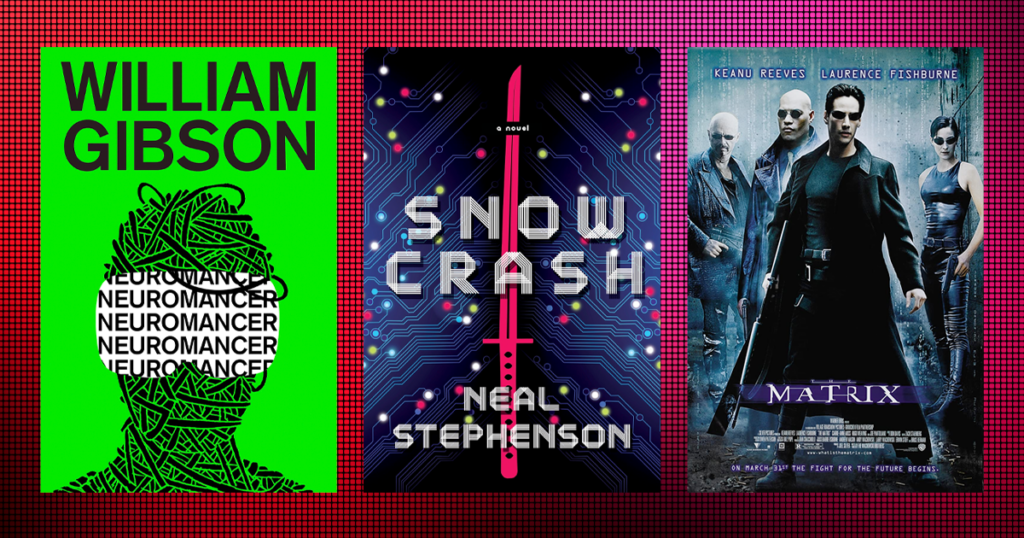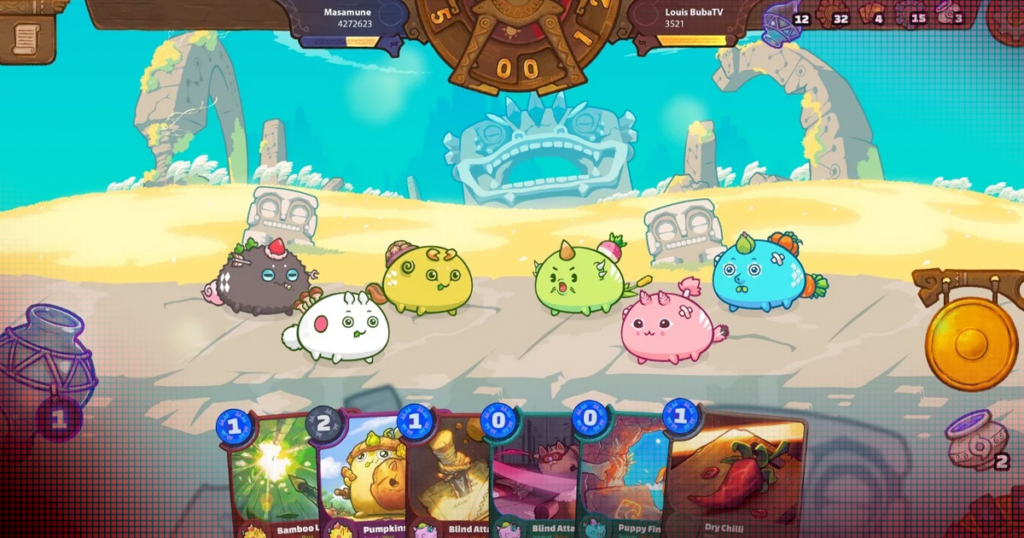
Neal Stephenson’s 1992 novel Snow Crash is a foundational work of both science-fiction and – more broadly – literature. So much so, that the novel made Time’s list of the 100 all-time English language books published.
Snow Crash features many elements which have gone on to become science-fiction and cyberpunk tropes. A dystopic America ruled by corporations, smoggy big cities frosted in neon, and of course the obligatory punk aesthetic. The novel is also famous for featuring the first known use of the word metaverse.
Of course, the concept of a digital world had been done before. William Gibson’s Neuromancer, published in 1984, prominently featured a digital world. And just as Stephenson coined metaverse, so too did Gibson invent the term “cyberspace”. Before that, a bevy of short stories and novels imagined virtual worlds, such as Pygmalion’s Spectacles, published in 1935. There has been a cavalcade of films, novels, and television shows that either take place in or deal with the existence of, a “metaverse.” The Matrix, perhaps the most famous example, took from Stephenson and Gibson as much as it did Descartes.

Now as we blaze ahead into the second decade of the 21st century, digital worlds seem all the more possible. Commercials for VR goggles play on television and Mark Zuckerberg – in an overt nod to Stephenson’s novel – renamed Facebook to Meta, reflecting the company’s push toward what they see as an inevitable virtual reality future.
And while Meta captures headlines, something missed is that humans have been living in digital worlds for a long time. Even before “the” was dropped from The Facebook.
A Third Place
When we’re talking about third places, we’re not talking about bronze metals. A third place, in the context we’ll be using it, is a marketing term. It’s a space that provides users with social experiences and relationships outside of their homes (first place) and offices (second place).
Working from home made the second place seem a bit antiquated and the first place feel a lot more stressful. But the third place exists the same as ever. Bars and coffee shops are great examples of third places. They’re spaces people gather to satisfy a need for social interaction with other human beings outside the home and work.
While coffee shops and bars – as well as restaurants, gyms, and parks – will always be around, nothing says a third place needs to be physical.
Going Digital
When World of Warcraft first hit the gaming scene in 2004, it brought the term MMORPG (massively multiplayer online game) mainstream. But these games had been around for a while. Runescape a free-to-play MMORPG released in 2001 is recognized by Guinness as the largest MMORPG in the world. And in 1985, a game called Island of Kesmai launched, which, according to some, is the first of the genre.
While at the time these were seen as simply video games, albeit advanced and groundbreaking ones, looking back on them now, they’re digital third places. Within the game worlds, people would gather to accomplish quests, chat, dance, and make friends. In other words, seek social connection.
While it may seem trite to make fun of Mark Zuckerberg for throwing all of his eggs into the metaverse basket, it’s actually more appropriate to make fun of him for coming to the party late. Digital third places in the form of MMORPGs suggest that we’ve been in some form of the metaverse for years now.
MMORPGs are obvious examples of digital third places. Because, like in Snow Crash and Neuromancer, players embody a character within the virtual world. But there are other, more prominent examples of digital third places or proto-metaverses. Even if you didn’t play World of Warcraft, you may have used AIM chat. Too young to remember AIM? Congratulations. But you were still on MySpace. Missed MySpace? Well, did you make a Facebook? No Facebook? Okay, well, maybe you’re on Twitter or Tik Tok or Lip Lap.
Okay, Lip Lap’s not real.
The point is unless you’re a total Luddite, you probably have taken some part in the creation or proliferation of the metaverse by entering a digital third place. Because after all, whether you call it the metaverse, cyberspace, the matrix, or The Facebook it’s all the internet.

NFT Games and the Future of the Third Place
Talk to any gamer and they’ll give you their thoughts on microtransactions. Some may wax nostalgic for the days when you bought a disc and that was that. But most are probably agnostic – or at least not openly hostile – towards them.
If you don’t know what microtransactions are, they’re just in-game purchases. They can be anything from new weapons and armor to a couch for your digital home. Fortnite, the free-to-play PVP (player-vs-player) game that swept through Gen-Z like a plague may be the most well-known – and perhaps most successful – example of their implementation. But other games like Clash of Clans and even World of Warcraft have in-game purchases.

While to some, in-game purchases may represent the death of gaming, a way for triple-A developers to bleed dry their audience (or their audience’s parents) for every penny, others see in-app purchases as a precursor of what’s to come. That being NFT games.
NFT games and NFTs in games already exist. Axie Infinity is just one example of a burgeoning new market of NFT games.
Developed by Vietnamese-based studio Sky Mavis, Axie Infinity allows players to collect and build kingdoms for creatures known as Axies. But what’s notable is the game’s Ethereum based, in-game economy that allows players to make real-world money.
While Axie Infinity is somewhat under-the-radar, there are big publishers who are looking towards a non-fungible future. Ubisoft, the company behind massive titles like Assasin’s Creed and Far Cry announced Quartz, a marketplace which allows players to purchase unique one-of-a-kind “digis” – aka NFTs – that can be used in games. And while they haven’t announced its use in any games outside of Ghost Recon: Breakpoint, having a huge publisher announce an NFT marketplace is a big step toward more games becoming NFT games.

But these games don’t just mean an interesting new direction for video games. They also point towards the future of the third place.
Meet Me in the Metaverse
If World of Warcraft and Runescape are early versions of the metaverse, then what games do now can be an early indication of what the metaverse will look like in the future. This means that NFT games like Axie Infinity point toward use-cases for NFTs in the non-gaming metaverse.
One simple way NFTs can be used in a non-gaming section of the metaverse would be as merchandise. In fact, there is already digital merchandise being sold as NFTs on Third Act. The difference, however, is that in the metaverse merch will act as merch does in the physical world. So, your character in the metaverse will wear that shirt you bought at the digital premiere of Wicked or your avatar can show off the Playbill you received at the metaverse matinee of Nice Work.
NFT games and video games, in general, are already doing this. It’s only a matter of time before the metaverse, cyberspace, or just the internet, in general, evolves to where NFT merchandise becomes the norm.
You might be asking, if NFT games prove out NFT’s function in the metaverse, what proves out theatre’s place in the metaverse? There’s of course no predicting the future. But it’s not a prediction to say that the future is going to be digital. And theatre is a great example of a digital frontier that’s being trailblazed in real-time.
While Hamilton is one of the most successful Broadway musicals of all time. In fact, the play is the top six grossing musicals ever, outpacing others that have been running more than a decade longer. Butˆ Hamilton has another title to its name. That being the top streamed piece of original content Disney+.

The fact that the recording of a play is one of the top streamed pieces of content ever is staggering, and it suggests theatre’s digital future. And as VR takes off, and the metaverse becomes reality (or some version of it does at least) it’s not hard to imagine slipping your VR goggles on to watch a show from the front row of a digital theatre.
Theatre’s Way Forward
The push towards virtual spaces will be a good thing for theatre. It offers more accessibility – giving people who live too far from major (mostly American) urban centers access to shows. It gives theatre productions, notorious when it comes to recouping investments, a better chance to succeed. And it democratizes the industry – allowing creators who may not have the funds to rent out a Broadway (or even off-Broadway) theatre to put their show up in an unlimited digital space.
NFTs will play a big role in theatre’s way forward. Merchandise is just one example of how NFTs can function in this theoretical meta-future. NFT games offer the blueprint of how digital collectibles can be used in this space. Costumes from digital shows can be minted as NFTs, given code on the blockchain, then sold. The same goes for props.
And NFTs can be offered up as keys that unlock VIP experiences, and not just ones that take place digitally, but physical experiences as well. A person can purchase an NFT ticket for a metaverse showing of a new musical, and that NFT can be used to meet the cast in real life.

The possibilities are as limited as your imagination, and luckily for theatre fans, theatre makers’ imaginations are unlimited.
The Here and Now
We’re far away from Zuckerberg’s version of the metaverse, a fully immersive digital world ala Snow Crash. And frankly, we may never get to that sci-fi version of things. But NFTs can help theatre productions now.
Digital collectibles represent untapped lines of evergreen revenue to help productions stay open longer. And they also allow for a better connection with fans. And shows that adopt NFTs now could be one step ahead later if the metaverse does truly become a reality. But some may argue that the metaverse is already here and that we’ve always been in it.

